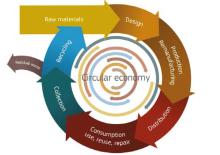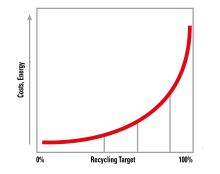On 2 December, 2015, the European Commission released its much expected new Circular Economy Package.
It was presented as even more ambitious than the previous package from July, 2014 withdrawn by the Juncker Commission. What should the aggregates industry expect from it?
The package consists of an Action Plan, an Implementation Plan and four legislative proposals, in particular proposals amending the Waste and Landfill Directives. The Action Plan sets out a number of existing and new initiatives to be launched and promoted in the next three years. The Implementation Plan summarises these measures and states how the European Commission can assist EU Member States in achieving these objectives.
Emphasis on the waste hierarchy
Often recycling and landfilling waste gets into the main focus, while waste should predominantly avoided or reused. For our industry, this means emphasis on the renovation of buildings and the repair of existing infrastructure.
Better implementation of the objectives
The new package recognises the potential of better implementation of existing policies and targets, and if necessary prosecution. Instead of Progress Reports submitted once every three years by the 28 EU Member States, the European Commission will use the support of the European Environment Agency and EUROSTAT being in possession of annually requested data sets from EU Member States. This should allow monitoring of progress or shortcomings at an early stage.
Workshops and other measures will assist countries which have particular problems with the implementation, or achieving progress. Better implementation also presupposes that national, regional and local competent authorities are equipped with the necessary highly qualified staff.
Possible confusion with a misleading “lead indicator”
The first package of the Barosso Commission measured Resource Efficiency by added value per tonne of raw material consumed. Regrettably, the new package keeps the lead indicator, although a set of additional indicators for resource efficiency (Resource Efficiency Scoreboard) corrects the first misleading picture. In particular, aggregates producers would be disadvantaged by such an indicator, since in principle the added value (GDP) would be compared to a tonne of sand with a tonne of critical raw materials. This weakness had already been recognised and other indicators are to be applied.
Economic instruments
The new package still puts a focus mainly on environmental aspects sidelining the associated costs. Obstacles for more recycling continue to be addressed with economic instruments, without explicitly naming commodity taxation.
In the context of the European Semester, UEPG was able to question aggregates taxation, with reference to the outstanding achievements on biodiversity. Nevertheless, the circular economy package refers to “financial incentives” to reduce backfilling which is an important part of reusing waste materials for restoration.
Recycling and backfilling
The circular economy package envisages an amendment of the Waste Directive. There will be no tightening of targets for reuse and recycling; the 70% target for 2020 and the possibility to include backfilling remains untouched. In the legislative proposal, backfilling means “any recovery operation where suitable waste is used for reclamation purposes in excavated areas or for engineering purposes in landscaping or construction instead of other non-waste materials which would otherwise have been used for that purpose.”
Member States are obliged to ensure the separate collection of waste (explicitly also for aggregates) “where technically, environmentally and economically practicable and appropriate to meet the necessary quality standards” and targets for the relevant recycling sectors.
By-products
Under certain conditions, a “substance or object resulting from a production process” where the “primary aim is not the production of that substance or object, should be considered not to be waste, but to be a by-product”.
The Commission will adopt delegated acts to obtain more detailed criteria. UEPG experts contribute to the development of an EU protocol for construction and demolition waste that will be presented during the year.
End-of-waste
The European Commission proposes that waste which has undergone a recovery operation is no longer considered as waste if the “substance or object” can be used for certain purposes. Whether there is a market or a demand for that material should no longer be a criteria. More details in this area are to be determined by the Commission.
List of waste
Until now, waste from sand and gravel sites and quarries are considered as inert. Monitoring the current debate on respirable crystalline silica, UEPG will devote special attention to the list of wastes.








